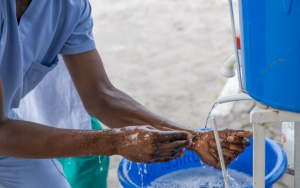Battling COVID-19 in communities
Kampala – In a low-income suburb of Makindye, in the Ugandan capital, Hakim Kiggundu has gathered a group of around 30 people from the community near his home, under a tree in a clearing among the houses. In this tight-knit community of narrow mud roads and small wooden houses, people are used to living cheek-by-jowl, but now they are sitting on neatly-spaced white plastic chairs, a few metres apart.
Kiggundu is here as part of the local village health team to educate people about COVID-19 – how to identify signs and symptoms and stay safe. A brief round of applause concludes a question-and-answer session before Kiggundu continues spreading the message, making house-to-house visits throughout the area. Makindye has in the past been divided into zones, with each assigned to one village health team to monitor outbreaks such as cholera or measles as well provide HIV counselling and prevention. Since the COVID-19 onset, there are now four teams per zone.
At first it was hard to persuade people that the disease was real, and that it could affect them, says Kiggundu. But as COVID-19 cases surged in recent weeks, reaching areas hitherto unaffected, the message has been more urgent to help change perceptions about the virus. “People understand because we teach them in our local language, Luganda,” Kiggundu points out.
The village health teams are trained volunteers who form part of the backbone of Uganda’s public health system. In the capital Kampala, there are more than 4000 volunteers in the various health teams. Their job is to communicate to people in their neighbourhoods about any outbreaks, how to avoid them, what signs and symptoms to look out for, and what to do if they fall ill or see people with symptoms.
Community involvement is crucial to the success of preventive measures such as handwashing, wearing masks and physical distancing, says Dr Dansan Atim, a senior medical officer with the surveillance division at the Ugandan Ministry of Health. “If we need to combat this pandemic then we need to involve everyone,” he says. “These [preventive measures] are the things to be implemented by the community. So their engagement is important … in the fight against COVID.”
Although safety messages were being broadcast through radio and television, having a trusted person come to distribute free cloth masks, answer questions and demonstrate correct hand hygiene wins people’s confidence and trust in health messages, says mother-of-two Rebecca Nalubwala after a visit by Kiggundu from the village health team.
“We trust him because he's a boy who grew up here. He has no bad intention towards us in our community. Hakim and the group teach people who have no access to television and radio,” Nalubwala says.
Uganda had recorded 9945 cumulative COVID-19 cases as of 13 October and currently has 765 active cases. The country witnessed a rise in infections from early August, but the numbers have been declining over the last three weeks.
With support from World Health Organization, village health teams across Kampala and neighbouring Wakiso district have received specialized training in surveillance and community outreach to better convey safety message in these areas where there has been an increase in COVID-19 cases in recent weeks. Dr Atim hopes that the training will help to improve reporting of COVID-19 cases.
Despite his 12 years’ experience in community outreach, Kiggundu believes the training has changed his approach to communication, which he says will also be useful in responding to other outbreaks by encouraging people to report symptoms to him and his colleagues or seek medical help.
“I learned more about detection and responding. You have to go and see if your community makes you aware that we have this pandemic, or we have this outbreak,” he explains. “We make them aware. That they be alert if they see any sign or symptom about any disease.”



